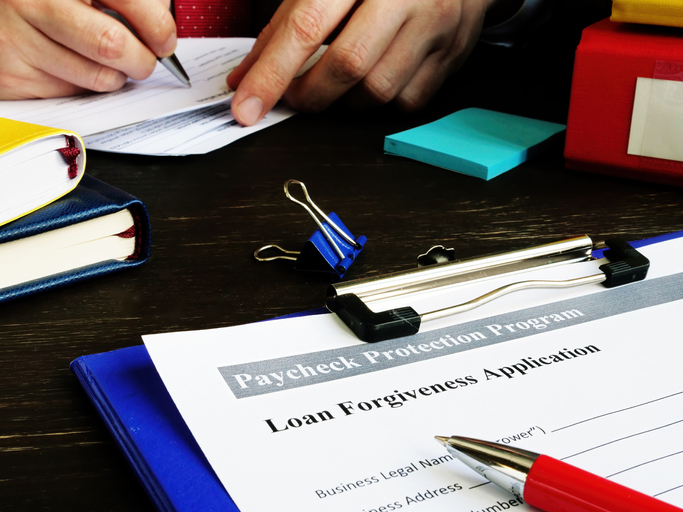Last week, the SBA, in conjunction with the U.S. Treasury, issued the revised PPP Loan Forgiveness Application, which incorporates changes as a result of the Paycheck Protection Program Flexibility Act (PPPFA). As you recall from previous emails, the PPPFA provided several new forgiveness criteria, which are incorporated in the Application:
- Payroll costs must be at least 60% of the amount forgiven, with nonpayroll costs accounting for no more than 40% of the amount forgiven. This replaces the previous 75/25 rule.
- The date for rehiring employees (Rehire Date) to apply for the FTE Safe Harbor and Wage Reduction Safe Harbor moved from June 30, 2020, to December 31,2020.
- The forgiveness covered period (Covered Period) expanded to 24 weeks, with an 8-week option if a loan was funded prior to June 5, 2020.
- Two new FTE Reduction Exemptions/Safe Harbors were introduced for borrowers unable to rehire an individual who was an employee on or before February 15, 2020, AND:
- Unable to hire similarly qualified employees on or before December 31, 2020, OR
- Unable to return to the same level of business activity that the business was operating at prior to February 15, 2020.
The Application and the June 22nd Interim Final Rule (IFR) offer several new provisions – some favorable, others limiting:
- The Rehire Date is now the earlier of the application date or December 31, 2020. This is a favorable provision allowing businesses to apply for forgiveness earlier than the end of the year, if they have resumed operations and hired back employees after the end of the Covered Period.
- The Application and instructions indicated the 24-week period or the 8-week period were the only two options that could be used for forgiveness. The IFR indicates forgiveness can be applied for prior to the end of the Covered Period, as long as any wage reduction calculations are done for the entire Covered Period. In other words, if funds are spent by week 11, a business can apply for forgiveness right away, but, if they have wage reductions for any employees, the reduction must be calculated across the entire 24-week period.
- The Application and IFR introduce a new twist on the FTE Safe Harbor. If the business is unable to operate between February 15, 2020, and the end of the Covered Period at the same level of business activity as before February 15, 2020, due to compliance with requirements established or guidance issued between March 1, 2020, and December 31, 2020, by the U.S. Department of Health and Human Services, the Centers for Disease Control and Prevention, or the Occupational Safety and Health Administration, related to the maintenance of standards for sanitation, social distancing, or any other worker or customer safety requirement related to COVID-19, the reduction in loan forgiveness as a result of a reduction in FTEs doesn’t apply.
- This is a favorable provision that should apply to all businesses impacted by COVID-19, whether they were considered essential or nonessential.
- The new IFR includes local directives as well, so closures or social distancing requirements issued by states also qualify.
- There is a new EZ Loan Forgiveness Application for businesses that don’t have reductions in FTEs or wages. These businesses can use the new EZ Application; however, they still need to do the payroll/nonpayroll calculations and provide support for those numbers when applying for forgiveness.
- Owner’s compensation is limited to 2019 compensation as follows:
- If the 24-week Covered Period is used, 2.5 months’ equivalent of the 2019 compensation (maximum of $20,833)
- If the 8-week Covered Period is used, 8 weeks’ equivalent of the 2019 compensation (maximum of $15,385)
- All business owners are included in the limits above, including shareholders of C Corporations and S Corporations.
- The following owner’s benefits are considered compensation and should not be separately included in the employees’ health insurance or retirement benefits line items on the Application:
- Self-employed, general partners, or S Corporation shareholders’ health insurance
- Self-employed and general partners retirement plan contributions
If you don’t have a PPP loan yet, the deadline to apply for one is right around the corner.
The June 30th deadline to apply for a PPP loan is swiftly approaching. The SBA has reinstated it’s Lender Match program to help connect small businesses with eligible lenders. As of June 22nd, the SBA approved more than $515 billion and still has funds remaining to lend.
“As communities begin to carefully reopen across the country, there are still many more opportunities to provide this assistance to businesses who have yet to access these forgivable loans,” said SBA Administrator Jovita Carranza.
Earlier this month, Democratic lawmakers introduced a bill, The Prioritized Paycheck Protection Program (P4) Act, that would, among other things, allow certain borrowers a second loan opportunity and extend the program through December 30, 2020, or later. The bill isn’t likely to make its way through Congress before the June 30th PPP deadline, nor is it likely to move before the Senate’s July 4th recess. With businesses still in need, however, and PPP funds still remaining, we expect Congress to take some action. We will keep you updated as related legislation continues to evolve.
We continue to work on programming the new workbook to provide you with a tool to calculate loan forgiveness based on these new provisions. Please contact us if you have questions or would like to strategize on maximizing loan forgiveness in the shortest covered period possible.
by Holly Ferguson, CPA





